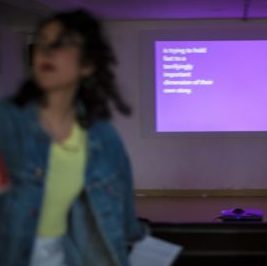Search
To search for an exact match, type the word or phrase you want in quotation marks.
A*DESK has been offering since 2002 contents about criticism and contemporary art. A*DESK has become consolidated thanks to all those who have believed in the project, all those who have followed us, debating, participating and collaborating. Many people have collaborated with A*DESK, and continue to do so. Their efforts, knowledge and belief in the project are what make it grow internationally. At A*DESK we have also generated work for over one hundred professionals in culture, from small collaborations with reviews and classes, to more prolonged and intense collaborations.
At A*DESK we believe in the need for free and universal access to culture and knowledge. We want to carry on being independent, remaining open to more ideas and opinions. If you believe in A*DESK, we need your backing to be able to continue. You can now participate in the project by supporting it. You can choose how much you want to contribute to the project.
You can decide how much you want to bring to the project.

“Do you remember that time we were together and danced this or that dance?” is the title of the performance by choreographer, writer and dance practitioner Clara Amaral that was presented in Tabakalera last November. It is a one-to-one performance where Amaral introduces the spectator to a publication she has learnt by heart. As in the artist’s words, “it is transmitted through an embodied memory”. She gives a precise account of all the features of the publication from its dimensions and the illustration of the cover, to the width and weight. Page after page we read and remember together the book and the idea of dancing.
Amaral’s performance follows a process similar to that of reverse engineering. It does not go forward as one would turn the pages of a book. It goes backward. It happens in images, dances, everyday gestures, sensations and smells that are not present. We are never given the product. There is no book or dance or stage, at least in their physical form. Reverse engineering does not make a product either, on the contrary, it analyses and steals it. It researches and deconstructs an object to understand step by step its production process. Once all the information about this process is revealed, one can use it to manufacture the same object. However, if that reproduction is ever made, it would not be a simple copy, it would be the outcome of a robbery.
Amaral’s performance has the power to return the spectator to a previous state – real or unreal – that produces the same reverse effect. An effect of subtraction, theft, flimflam, fraud. She plays with words that expose while at the same time hide. It speculates. It tricks us to change the perspective on the idea of movement to transform everyday dances. It seems that by learning the rhythm of what we do without thinking we can corrupt it, steal it and make it our own. Amaral does not tell a story or try to persuade us to believe in a plot. She does not impose a narrative, she guesses, she asks: Do you remember? The spectator becomes her partner in crime because together they steal the rhythm from everyday life and automatic movements. In this performance, there is a time when they both wake up in the middle of the night, dance and go back to sleep.
In Amaral’s performance, stealing – not appropriation or lending – is a form of radical sharing. A mode of letting ourselves be carried away by the erotic sense of other dances. Stealing is an inaccurate activity which is often misunderstood. It means copying for reverse engineers, it was equality for Robin Hood, whereas for others is just a mere way of misplacing things.

Amaral probably thinks that stealing can be a form of conspiracy. It could actually be this or that robbery, like the dance she tells us that we danced together in the past but it was a lie. She said it so we could invent the present and be together in the inaccuracy of what we may remember from her publication. Conspiracy restores the difference between you and me because we are doing something that is only ours. This conspiracy, as Valentina Desideri and Stefano Harney suggest, calls forth a complicit love, a love on the side of conspiracy and against the plot. In Amaral’s performance, the conspiracy will be read in its potential to reverse, steal or remember common dances, this or that dance.
The performance “Do you remember that time we were together and danced this or that dance?” by Clara Amaral was shown in the context of Emotional, a project by Emilio Moreno.
(Do you Remember that time we were together and danced this or that dance? Clara Amaral. Photo: DOSMASENLAMESA for EMOTIONAL, at Tabakalera).

Helena Grande writes, publishes, sometimes organizes exhibitions and projections, makes videos and a lot of autofiction. She is interested in everything that entangles scientific literature, poetry and the ordinary. You can find her in Amsterdam and at times in Madrid.
"A desk is a dangerous place from which to watch the world" (John Le Carré)